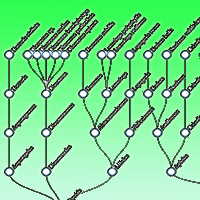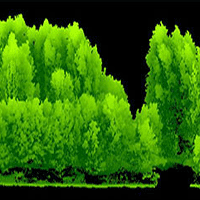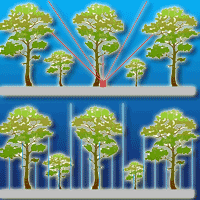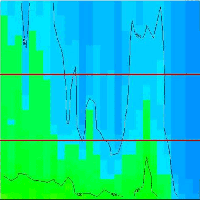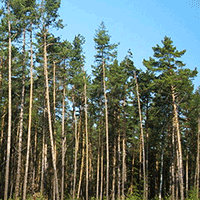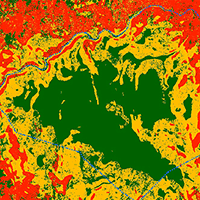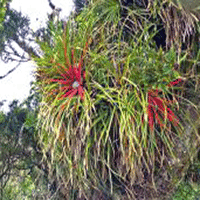
The importance of tree species and size for the epiphytic bromeliad Fascicularia bicolor in a South-American temperate rainforest (Chile)
Gabriel Ortega-Solís (1-5) , Iván Díaz (2), Daniela Mellado-Mansilla (2), Ricardo Moreno-González (3), Javier Godoy (2), Horacio Samaniego (4)
iForest - Biogeosciences and Forestry, Volume 13, Issue 2, Pages 92-97 (2020)
doi: https://doi.org/10.3832/ifor2710-013
Published: Mar 10, 2020 - Copyright © 2020 SISEF
Short Communications
Abstract
Bromeliads are a numerous family of vascular epiphytes, though only one epiphytic species inhabits South-American temperate rainforests: the endemic Fascicularia bicolor. This bromeliad is an important driver of canopy biodiversity, but attributes of its hosts are mostly unknown. Here we report (i) the tree species colonized by F. bicolor, (ii) the relationship between tree size and presence of F. bicolor and (iii) the relation between tree size and the number of mats of F. bicolor inhabiting each colonized tree. We sampled 231 trees in seven forest plots recording their species, diameter, heights, and the number of F. bicolor mats growing on them. The dataset was analyzed with a zero-inflated model to relate host tree attributes with F. bicolor occurrence and abundance in a single statistical approach. The occurrence and abundance of F. bicolor depend on host-species identity and diameter. F. bicolor colonization in slow-growing trees started at smaller DBH than that required for other tree species. Nonetheless, the overall occurrence of F. bicolor relies on large trees above 50 cm DBH for most host species. The number of mats occurring on each colonized tree depends on the interaction between tree height and species suggesting the importance of space available for colonization along the tree-trunk, and differential effects due to species’ traits. Currently, large trees and old-growth forests are scarce within the distribution range of F. bicolor, which could seriously affect the long-term conservation of this endemic epiphyte, along with the canopy properties and species associated with it.
Keywords
Forest Canopy, Epiphytes, Bromeliads, South American Temperate Forests
Authors’ Info
Authors’ address
Unidad de Gestión Ambiental, Dirección de Servicios, Vicerrectoría de Gestión Económica y Administrativa, Universidad Austral de Chile, Las Encinas 220, Valdivia (Chile)
Daniela Mellado-Mansilla
Javier Godoy
Laboratorio de Biodiversidad y Ecología del Dosel, Instituto de Conservación, Biodiversidad y Territorio, Facultad de Ciencias Forestales y Recursos Naturales, Universidad Austral de Chile, Independencia 641, Valdivia (Chile)
Department of Palynology and Climate Dynamics, Albrecht-von-Haller-Institute for Plant Sciences, University of Göttingen, Untere Karspüle 2, 37073 Göttingen (Germany)
Laboratorio de Ecoinformática, Instituto de Conservación, Biodiversidad y Territorio, Facultad de Ciencias Forestales y Recursos Naturales, Universidad Austral de Chile, Independencia 641, Valdivia (Chile)
Escuela de Graduados, Facultad de Ciencias Forestales y Recursos Naturales, Universidad Austral de Chile, Independencia 641, Valdivia (Chile)
Corresponding author
Paper Info
Citation
Ortega-Solís G, Díaz I, Mellado-Mansilla D, Moreno-González R, Godoy J, Samaniego H (2020). The importance of tree species and size for the epiphytic bromeliad Fascicularia bicolor in a South-American temperate rainforest (Chile). iForest 13: 92-97. - doi: 10.3832/ifor2710-013
Academic Editor
Michele Carbognani
Paper history
Received: Dec 08, 2017
Accepted: Jan 04, 2020
First online: Mar 10, 2020
Publication Date: Apr 30, 2020
Publication Time: 2.20 months
Copyright Information
© SISEF - The Italian Society of Silviculture and Forest Ecology 2020
Open Access
This article is distributed under the terms of the Creative Commons Attribution-Non Commercial 4.0 International (https://creativecommons.org/licenses/by-nc/4.0/), which permits unrestricted use, distribution, and reproduction in any medium, provided you give appropriate credit to the original author(s) and the source, provide a link to the Creative Commons license, and indicate if changes were made.
Web Metrics
Breakdown by View Type
Article Usage
Total Article Views: 42960
(from publication date up to now)
Breakdown by View Type
HTML Page Views: 36342
Abstract Page Views: 3451
PDF Downloads: 2351
Citation/Reference Downloads: 1
XML Downloads: 815
Web Metrics
Days since publication: 2124
Overall contacts: 42960
Avg. contacts per week: 141.58
Citation Metrics
Article Citations
Article citations are based on data periodically collected from the Clarivate Web of Science web site
(last update: Mar 2025)
Total number of cites (since 2020): 3
Average cites per year: 0.50
Publication Metrics
by Dimensions ©
Articles citing this article
List of the papers citing this article based on CrossRef Cited-by.
References
Proyecto catastro y evaluación de los recursos vegetacionales nativos de Chile [Cadastre and evaluation of Chile’s native vegetation resources project]. Corporación Nacional Forestal - CONAF, Santiago, Chile, pp. 87.
Gscholar
Las especies arbóreas de los bosques templados de Chile y Argentina: autoecología [The arboreal species of the temperate forest of Chile and Argentina: autoecology]. Marisa Cuneo Ediciones, Valdivia, Chile, pp. 678. [in Spanish]
Gscholar
When a private park supports the local economy. In: “Investing in sustainable mountain development: Opportunities, resources and benefits” (Wymann von Dach S, Bachmann F, Borsdorf A, Kohler T, Jurek M, Sharma eds). Centre for Development and Environment (CDE), University of Bern, Switzerland, pp. 3.
CrossRef | Gscholar

